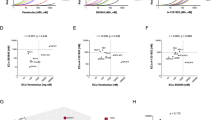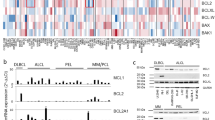Abstract
The serine/threonine kinase AMP-activated protein kinase (AMPK) and its downstream effectors, including endothelial nitric oxide synthase and BCL-2, are hyperactivated in B-cell precursor-acute lymphoblastic leukemia (BCP-ALL) cells with MLL gene rearrangements. We investigated the role of activated AMPK in supporting leukemic cell survival and evaluated AMPK as a potential drug target. Exposure of leukemic cells to the commercial AMPK inhibitor compound C resulted in massive apoptosis only in cells with MLL gene rearrangements. These results were confirmed by targeting AMPK with specific short hairpin RNAs. Compound C-induced apoptosis was associated with mitochondrial membrane depolarization, reactive oxygen species production, cytochrome c release and caspases cleavage, indicating intrinsic apoptosis pathway activation. Treatment with low concentrations of compound C resulted in a strong antileukemic activity, together with cytochrome c release and cleavage of caspases and poly(ADP-ribose) polymerase, also in MLL-rearranged primary BCP-ALL samples. Moreover, AMPK inhibition in MLL-rearranged cell lines synergistically enhanced the antiproliferative effects of vincristine, daunorubicin, cytarabine, dexamethasone and L-asparaginase in most of the evaluated conditions. Taken together, these results indicate that the activation of the AMPK pathway directly contributes to the survival of MLL-rearranged BCP-ALL cells and AMPK inhibitors could represent a new therapeutic strategy for this high-risk leukemia.
This is a preview of subscription content, access via your institution
Access options
Subscribe to this journal
Receive 12 print issues and online access
$259.00 per year
only $21.58 per issue
Buy this article
- Purchase on Springer Link
- Instant access to full article PDF
Prices may be subject to local taxes which are calculated during checkout






Similar content being viewed by others
References
Hardie DG, Carling D, Carlson M . The AMP-activated/SNF1 protein kinase subfamily: metabolic sensors of the eukaryotic cell? Annu Rev Biochem 1998; 67: 821–855.
Hardie DG, Hawley SA, Scott JW . AMP-activated protein kinase--development of the energy sensor concept. J Physiol 2006; 574: 7–15.
Xiao B, Heath R, Saiu P, Leiper FC, Leone P, Jing C et al. Structural basis for AMP binding to mammalian AMP-activated protein kinase. Nature 2007; 449: 496–500.
Alessi DR, Sakamoto K, Bayascas JR . LKB1-dependent signaling pathways. Annu Rev Biochem 2006; 75: 137–163.
Motoshima H, Goldstein BJ, Igata M, Araki E . AMPK and cell proliferation--AMPK as a therapeutic target for atherosclerosis and cancer. J Physiol 2006; 574: 63–71.
Yamauchi T, Kamon J, Minokoshi Y, Ito Y, Waki H, Uchida S et al. Adiponectin stimulates glucose utilization and fatty-acid oxidation by activating AMP-activated protein kinase. Nat Med 2002; 8: 1288–1295.
Minokoshi Y, Kim YB, Peroni OD, Fryer LG, Müller C, Carling D et al. Leptin stimulates fatty-acid oxidation by activating AMP-activated protein kinase. Nature 2002; 415: 339–343.
Hardie DG, Carling D . The AMP-activated protein kinase--fuel gauge of the mammalian cell? Eur J Biochem 1997; 246: 259–273.
Hardie DG . The AMP-activated protein kinase pathway--new players upstream and downstream. J Cell Sci 2004; 117: 5479–5487.
Wang W, Guan KL . AMP-activated protein kinase and cancer. Acta Physiol (Oxf) 2009; 196: 55–63.
Fogarty S, Hardie DG . Development of protein kinase activators: AMPK as a target in metabolic disorders and cancer. Biochim Biophys Acta 2010; 1804: 581–591.
Green AS, Chapuis N, Maciel TT, Willems L, Lambert M, Arnoult C et al. The LKB1/AMPK signaling pathway has tumor suppressor activity in acute myeloid leukemia through the repression of mTOR-dependent oncogenic mRNA translation. Blood 2010; 116: 4262–4273.
Zhou W, Han WF, Landree LE, Thupari JN, Pinn ML, Bililign T et al. Fatty acid synthase inhibition activates AMP-activated protein kinase in SKOV3 human ovarian cancer cells. Cancer Res 2007; 67: 2964–2971.
Rattan R, Giri S, Singh AK, Singh I . 5-Aminoimidazole-4-carboxamide-1-beta-D-ribofuranoside inhibits cancer cell proliferation in vitro and in vivo via AMP-activated protein kinase. J Biol Chem 2005; 280: 39582–39593.
Okoshi R, Ozaki T, Yamamoto H, Ando K, Koida N, Ono S et al. Activation of AMP-activated protein kinase induces p53-dependent apoptotic cell death in response to energetic stress. J Biol Chem 2008; 283: 3979–3987.
Baumann P, Mandl-Weber S, Emmerich B, Straka C, Schmidmaier R . Inhibition of adenosine monophosphate-activated protein kinase induces apoptosis in multiple myeloma cells. Anticancer Drugs 2007; 18: 405–410.
Park HU, Suy S, Danner M, Dailey V, Zhang Y, Li H et al. AMP-activated protein kinase promotes human prostate cancer cell growth and survival. Mol Cancer Ther 2009; 8: 733–741.
Vucicevic L, Misirkic M, Janjetovic K, Harhaji-Trajkovic L, Prica M, Stevanovic D et al. AMP-activated protein kinase-dependent and -independent mechanisms underlying in vitro antiglioma action of compound C. Biochem Pharmacol 2009; 77: 1684–1693.
Accordi B, Espina V, Giordan M, VanMeter A, Milani G, Galla L et al. Functional protein network activation mapping reveals new potential molecular drug targets for poor prognosis pediatric BCP-ALL. PLoS One 2010; 5: e13552.
Gobbi A, Di Berardino C, Scanziani E, Garofalo A, Rivolta A, Fontana G et al. A human acute lymphoblastic leukemia line with the T(4;11) translocation as a model of minimal residual disease in SCID mice. Leuk Res 1997; 21: 1107–1114.
Viola G, Fortunato E, Cecconet L, Del Giudice L, Dall’Acqua F, Basso G . Central role of mitochondria and p53 in PUVA-induced apoptosis in human keratinocytes cell line NCTC-2544. Toxicol Appl Pharmacol 2008; 227: 84–96.
Indraccolo S, Tisato V, Tosello V, Habeler W, Esposito G, Moserle L et al. Interferon-alpha gene therapy by lentiviral vectors contrasts ovarian cancer growth through angiogenesis inhibition. Hum Gene Ther 2005; 16: 957–970.
Accordi B, Pillozzi S, Dell’Orto MC, Cazzaniga G, Arcangeli A, Kronnie GT et al. Hepatocyte growth factor receptor c-MET is associated with FAS and when activated enhances drug-induced apoptosis in pediatric B acute lymphoblastic leukemia with TEL-AML1 translocation. J Biol Chem 2007; 282: 29384–29393.
Basso G, Buldini B, De Zen L, Orfao A . New methodologic approaches for immunophenotyping acute leukemias. Heamatologica 2001; 86: 675–692.
Mihara K, Imai C, Coustan-Smith E, Dome JS, Dominici M, Vanin E et al. Development and functional characterization of human bone marrow mesenchymal cells immortalized by enforced expression of telomerase. Br J Haematol 2003; 120: 846–849.
Chou TC, Talalay P . Analysis of combined drug effects: a new look at a very old problem. Trends Pharmacol Sci 1983; 4: 450–454.
Chen MB, Shen WX, Yang Y, Wu XY, Gu JH, Lu PH . Activation of AMP-activated protein kinase is involved in vincristine-induced cell apoptosis in B16 melanoma cell. J Cell Physiol 2011; 226: 1915–1925.
Zhang WB, Wang Z, Shu F, Jin YH, Liu HY, Wang QJ et al. Activation of AMP-activated protein kinase by temozolomide contributes to apoptosis in glioblastoma cells via p53 activation and mTORC1 inhibition. J Biol Chem 2010; 285: 40461–40471.
Liu B, Fan Z, Edgerton SM, Deng XS, Alimova IN, Lind SE et al. Metformin induces unique biological and molecular responses in triple negative breast cancer cells. Cell Cycle 2009; 8: 2031–2040.
Woodard J, Joshi S, Viollet B, Hay N, Platanias LC . AMPK as a therapeutic target in renal cell carcinoma. Cancer Biol Ther 2010; 10: 1168–1177.
Sengupta TK, Leclerc GM, Hsieh-Kinser TT, Leclerc GJ, Singh I, Barredo JC . Cytotoxic effect of 5-aminoimidazole-4-carboxamide-1-beta-4-ribofuranoside (AICAR) on childhood acute lymphoblastic leukemia (ALL) cells: implication for targeted therapy. Mol Cancer 2007; 6: 46.
Kuznetsov JN, Leclerc GJ, Leclerc GM, Barredo JC . AMPK and Akt determine apoptotic cell death following perturbations of one-carbon metabolism by regulating ER stress in acute lymphoblastic leukemia. Mol Cancer Ther 2011; 10: 437–447.
Shaw MM, Gurr WK, McCrimmon RJ, Schorderet DF, Sherwin RS . 5'AMP-activated protein kinase alpha deficiency enhances stress-induced apoptosis in BHK and PC12 cells. J Cell Mol Med 2007; 11: 286–298.
Mizrachy-Schwartz S, Cohen N, Klein S, Kravchenko-Balasha N, Levitzki A . Up-regulation of AMPK in cancer cell lines is mediated through c-Src activation. J Biol Chem 2011; 286: 15268–15277.
Byekova YA, Herrmann JL, Xu J, Elmets CA, Athar M . Liver kinase B1 (LKB1) in the pathogenesis of UVB-induced murine basal cell carcinoma. Arch Biochem Biophys 2011; 508: 204–211.
Lee JH, Koh H, Kim M, Kim Y, Lee SY, Karess RE et al. Energy-dependent regulation of cell structure by AMP-activated protein kinase. Nature 2007; 447: 1017–1020.
Bonaccorsi S, Mottier V, Giansanti MG, Bolkan BJ, Williams B, Goldberg ML et al. The Drosophila Lkb1 kinase is required for spindle formation and asymmetric neuroblast division. Development 2007; 134: 2183–2193.
Acknowledgements
We thank Dr E Giarin for helping us with the BioBank and Dr R Bortolozzi for figures editing. We are also grateful to Professor D Campana for providing MSCs and constructive comments on the manuscript. This work was supported by grants from the Istituto Superiore di Sanità (Italy/USA program), the Fondazione Città della Speranza, the Associazione Italiana per la Ricerca sul Cancro, the Ministero della Salute (Ricerca Finalizzata 2006—Programma Integrato Oncologia) to GB. Progetto d'Ateneo—Bando 2010 to S.I. and Progetto d'Eccellenza Fondazione CARIPARO to SI and G. teK.
Author information
Authors and Affiliations
Corresponding author
Ethics declarations
Competing interests
BA, LL, EP, and GB are co-inventors on pending patent applications that cover findings within this paper and the authors could receive royalties as a consequence. These applications have been licensed to Theranostics Health, Inc., and LL and EP are equity shareholders. The other authors declare no competing financial interests.
Additional information
Supplementary Information accompanies the paper on the Leukemia website
Rights and permissions
About this article
Cite this article
Accordi, B., Galla, L., Milani, G. et al. AMPK inhibition enhances apoptosis in MLL-rearranged pediatric B-acute lymphoblastic leukemia cells. Leukemia 27, 1019–1027 (2013). https://doi.org/10.1038/leu.2012.338
Received:
Revised:
Accepted:
Published:
Issue Date:
DOI: https://doi.org/10.1038/leu.2012.338
Keywords
This article is cited by
-
Compound C induces autophagy and apoptosis in parental and hydroquinone-selected malignant leukemia cells through the ROS/p38 MAPK/AMPK/TET2/FOXP3 axis
Cell Biology and Toxicology (2020)
-
Impact of diverse chemotherapeutic agents and external factors on activation of brown adipose tissue in a large patient collective
Scientific Reports (2019)
-
The evolution of clinical trials for infant acute lymphoblastic leukemia
Blood Cancer Journal (2014)
-
In focus: MLL-rearranged leukemia
Leukemia (2013)



